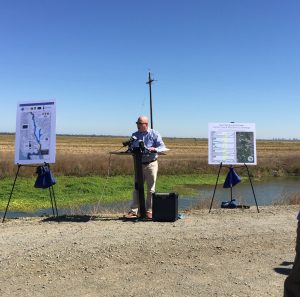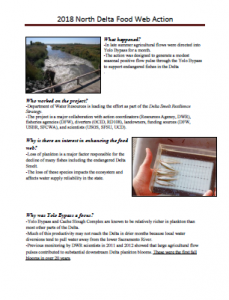Various partners in a program to provide food for Delta smelt joined together yesterday along the Yolo Bypass levee to present of the program’s monitoring this year, which showed promising results. This is the second year state and federal agencies, water resources managers, and landowners have collaborated to grow and transport food into the north Delta for smelt. This program is part of a larger effort to re-imagine a 21st century water system where the Yolo Bypass and the floodplain in the Sacramento Valley are reactivated to improve conditions for fish and wildlife, including smelt, salmon and birds. The effort also supports the Delta Smelt Resiliency Strategy.
The information below summarizes the program and the monitoring results for this year.

Food Production Program Continues to Improve
Delta Smelt Conditions
October 8, 2018
WOODLAND – The second year of a program to improve conditions for endangered Delta smelt shows great promise in creating a bloom in the plankton that nourish these imperiled fish. State and federal water leaders were joined today by Sacramento Valley farmers and water providers along the banks of the Yolo Bypass to hail the importance of the Delta Smelt Resiliency Strategy, a multipronged effort around restoring wetland habitat across the Sacramento-San Joaquin River Delta to bolster the smelt population. The strategy will re-activate the floodplain in the Sacramento Valley for the benefit of fish and wildlife, farms, cities and rural communities. “Current scientific efforts like this program are reinforcing the importance of reactivating floodplains in the Sacramento Valley,” said David Guy, President of the Northern California Water Association. He added, “Spreading water out and slowing it down over this mosaic of farmlands, refuges, bypasses and managed wetlands mimics natural flows and provides multiple benefits by reactivating the historic floodplain – with people, fish birds and wildlife coexisting in harmony.”
A key part of the strategy is this year’s “flow pulse” that creates a plankton bloom that smelt can feed from. Under the flow pulse, water is redirected from the Sacramento River down the Colusa Basin Drain, through the Knights Landing Ridge Cut Slough, past Wallace Weir, through the Yolo Bypass and into the Delta. The water flowing downstream to the Delta is rich with phytoplankton, a microscopic algae that helps create the critical food source for growing Delta smelt.
State, federal and local water district officials partnered this summer to send water through a wetland and tidal slough corridor of the Sacramento River system and into the Delta where it created a phytoplankton bloom, the foundation of the food web for smelt. This effort follows an original experiment, which was conducted in 2016. That study was developed from observations by agency scientists in the fall of 2011 and 2012 following larger-than-normal agricultural drainage flows from the Yolo Bypass. These flows produced an unusual plankton bloom in the Rio Vista area of the lower Sacramento River. Scientists theorized that this production of plankton could be generated in other years if the conditions in the Yolo Bypass could be repeated, effectively boosting downstream food web resources for smelt.
“This is a fairly promising approach,” said Ted Sommer, Lead Scientist with the California Department of Water Resources. “We seem to be getting a pretty good bang for our buck for the modest amount of water involved this year. The hope is that by doing this several years, we will figure out a long-term strategy to optimize how to use these flow pulses to help fish.”
This cooperative effort earlier this summer between state and federal governments and various water agencies along the Sacramento River including the Glenn- Colusa Irrigation District, Reclamation District 108, Reclamation 2035, Knaggs Ranch, and Conaway Ranch. The Tehama-Colusa Canal Authority and the U.S. Bureau of Reclamation assisted, along with many other local agricultural partners in the Valley. The result was a redirection of water from the Sacramento River down the Colusa Basin Drain, through the Knights Landing Ridge Cut Slough, past Wallace Weir, through the Yolo Bypass and into the Delta to provide the optimal conditions to create the critical food source for growing Delta smelt. This water created a flow pulse that generated a wave of phytoplankton that moved downstream to the Delta, effectively boosting downstream food web resources for smelt.
“Sacramento Valley farming and water management entities, including River Garden Farms are learning more each year on how we can manage resources to provide benefits for fish and birds while maintaining lands for farming and other uses,” said Roger Cornwell, Manager of River Garden Farms. He added, “This program to grow food for Delta smelt is an ideal example of the collaborative partnerships landowners, water managers, state and federal agencies and the region’s academic institutions are creating to promote the recovery of the Sacramento Valley’s species, including Delta smelt, salmon and birds and other species that utilize the Pacific Flyway.”
This effort supports the Delta Smelt Resiliency Strategy which is being implemented by the California Department of Fish and Wildlife, the California Department of Water Resources, the Division of Boating and Waterways, the U.S. Fish and Wildlife Service and the U.S. Bureau of Reclamation. The smelt food production plan is being executed through a partnership involving local, state and federal agencies teaming up with Sacramento Valley agricultural water users and farmers. This is the latest chapter of cooperation involving a coalition of farmers, water providers, conservationists and regulators who are driven by the mindset to “fix it” rather than “fight it” to improve fish and wildlife habitat throughout the Sacramento River region.
Click HERE to view to full press release.




